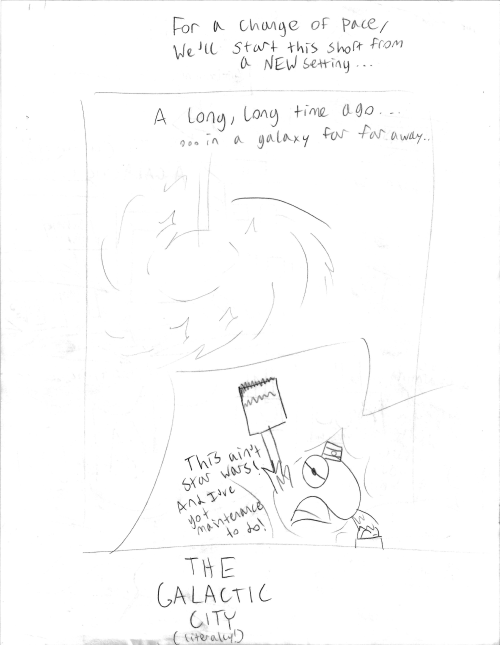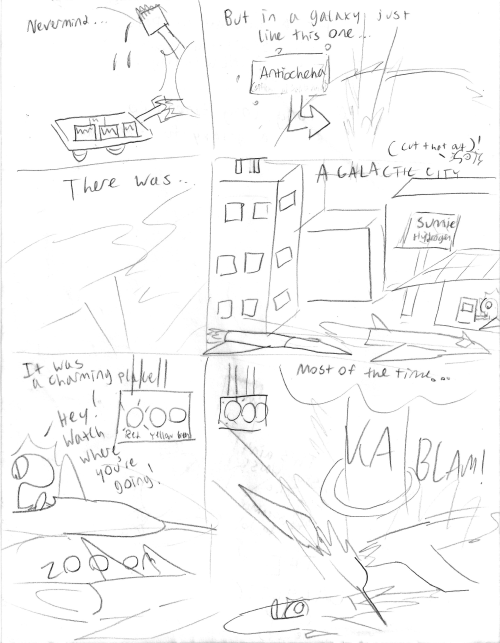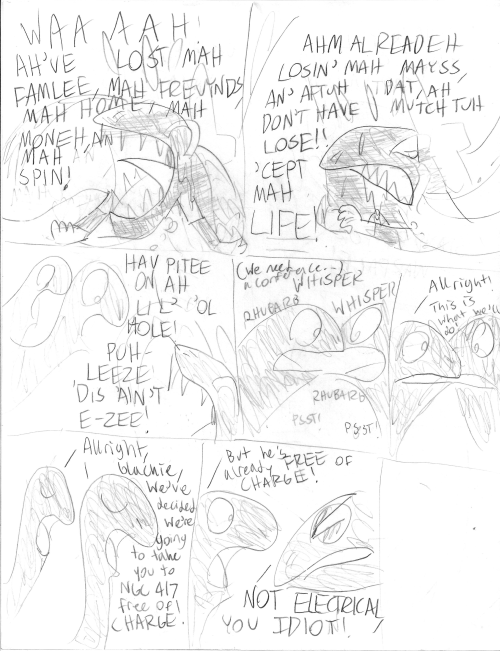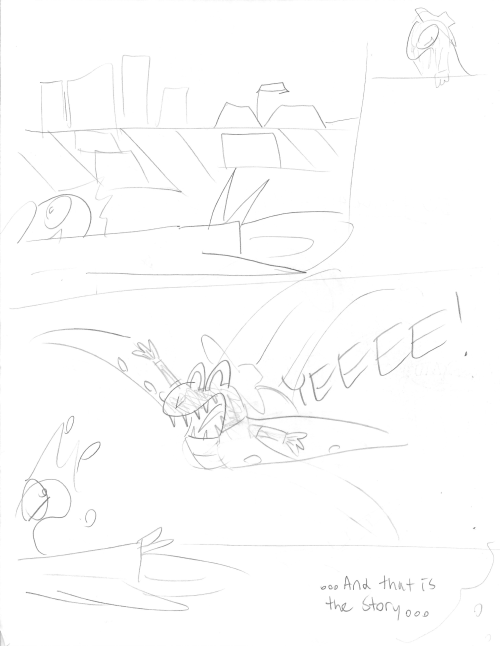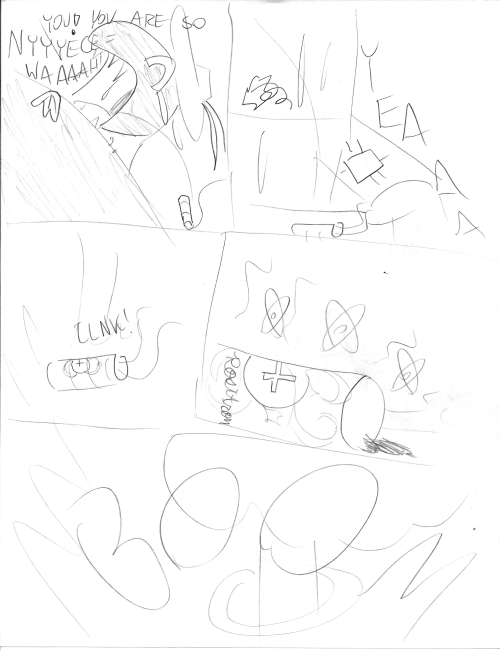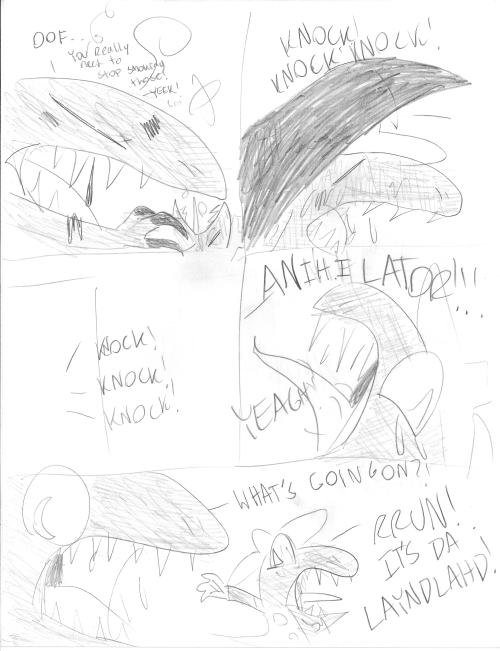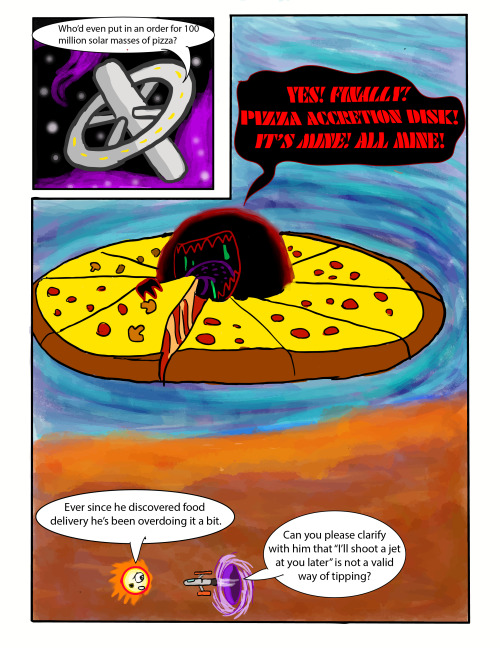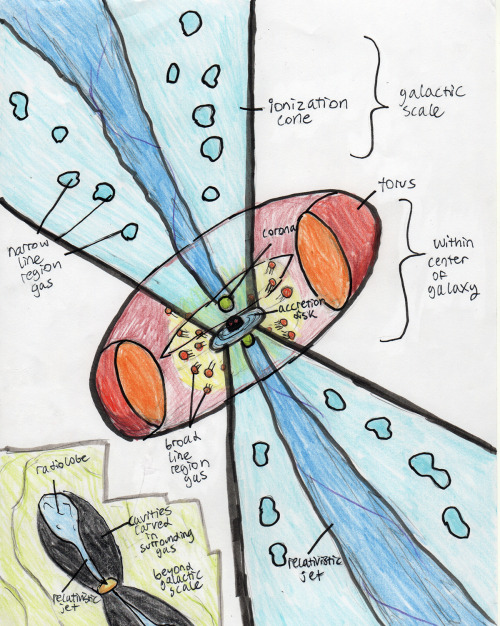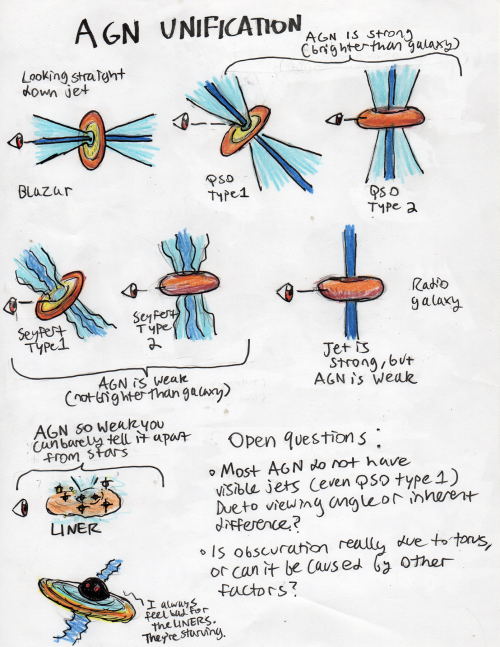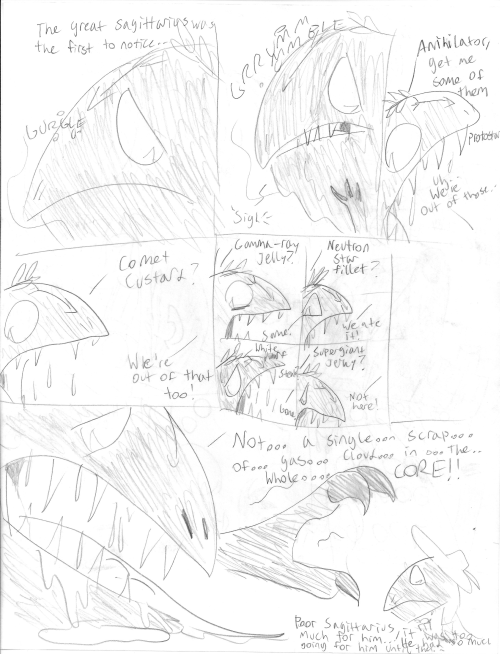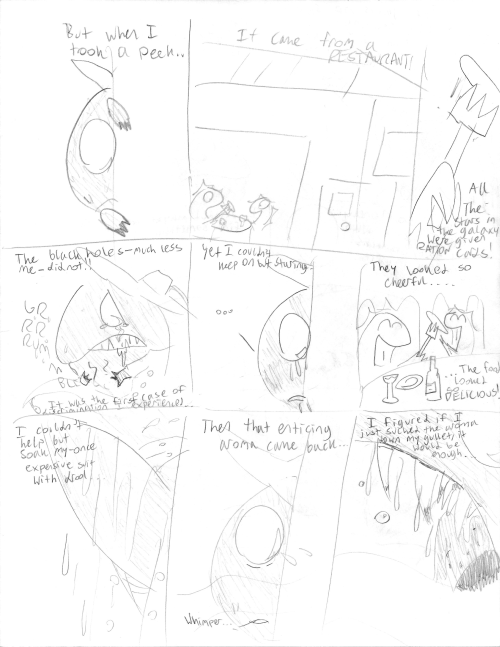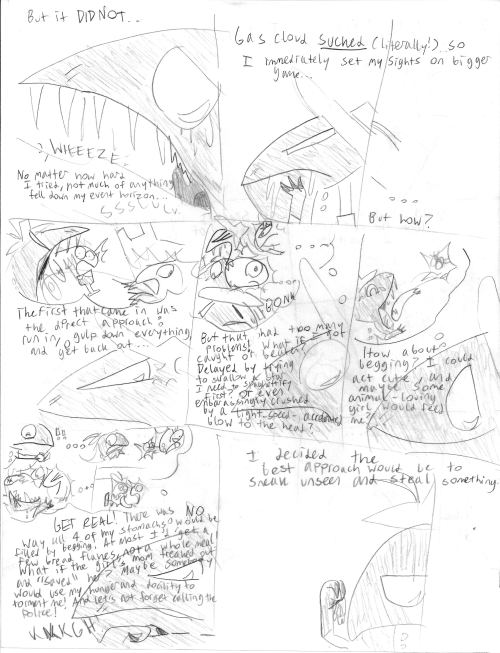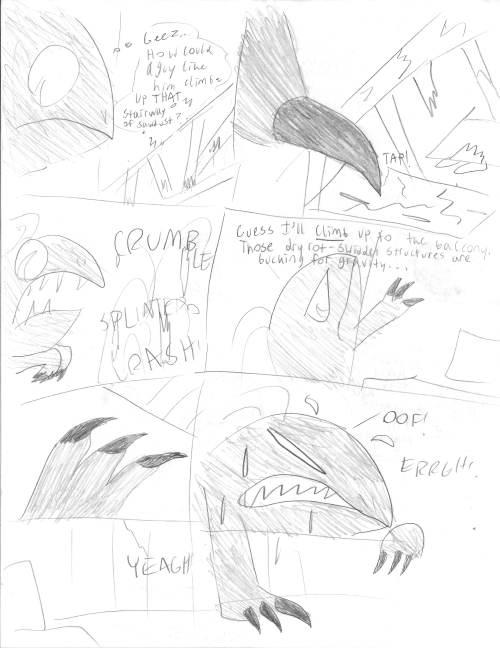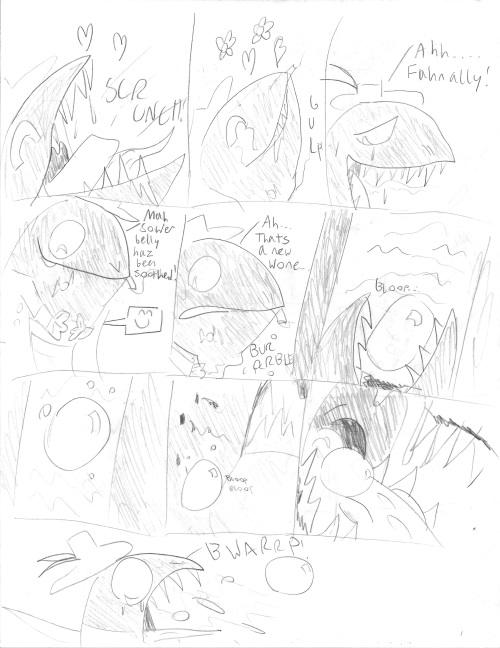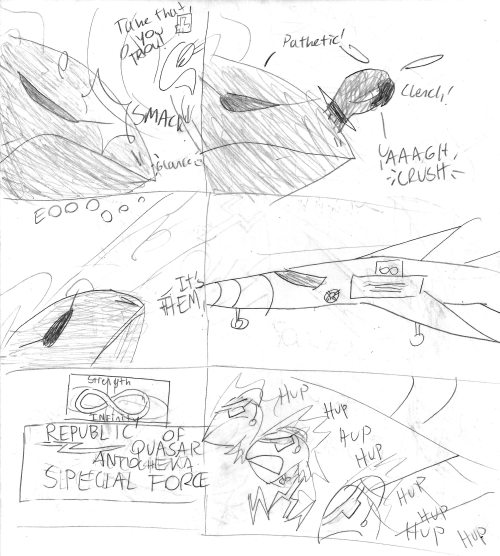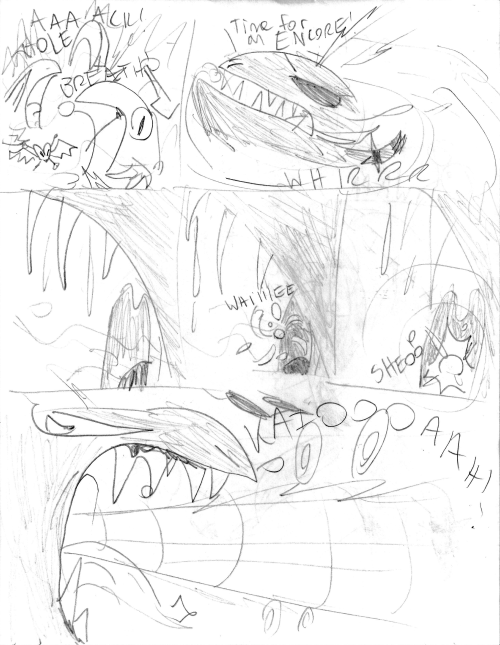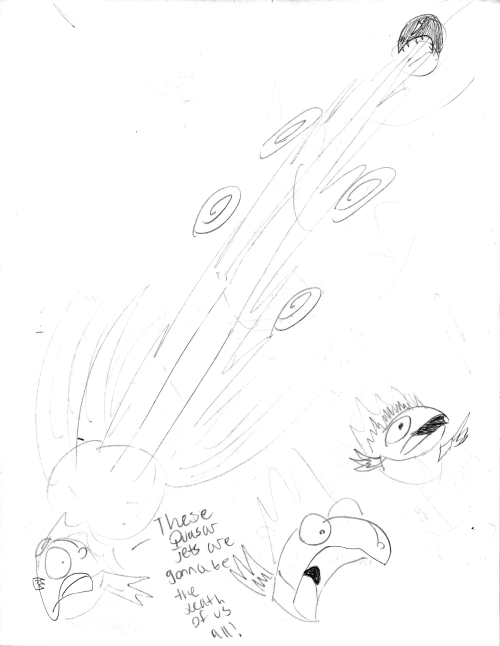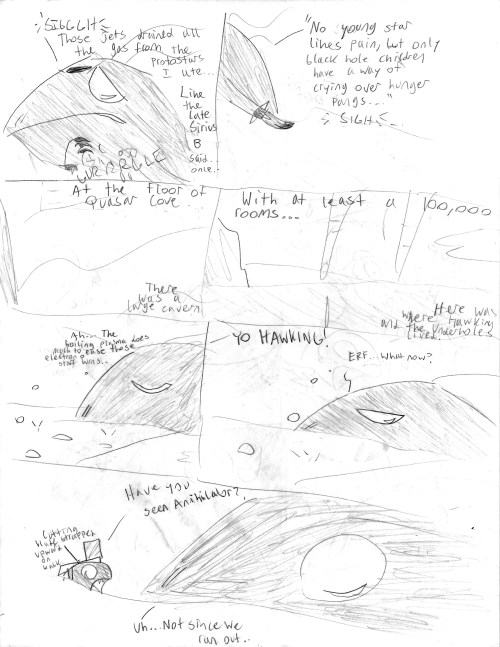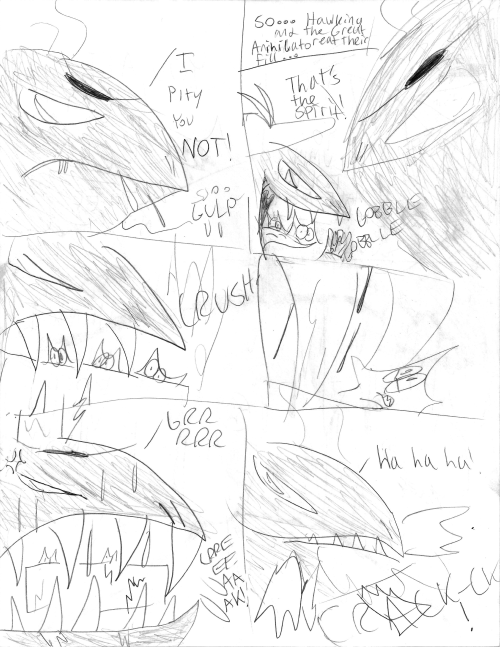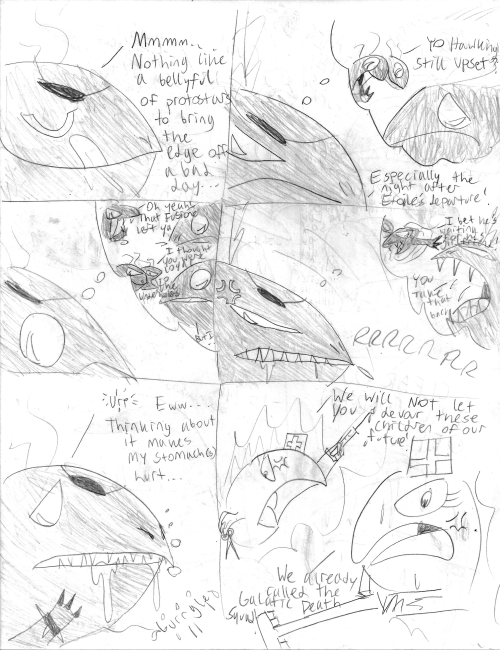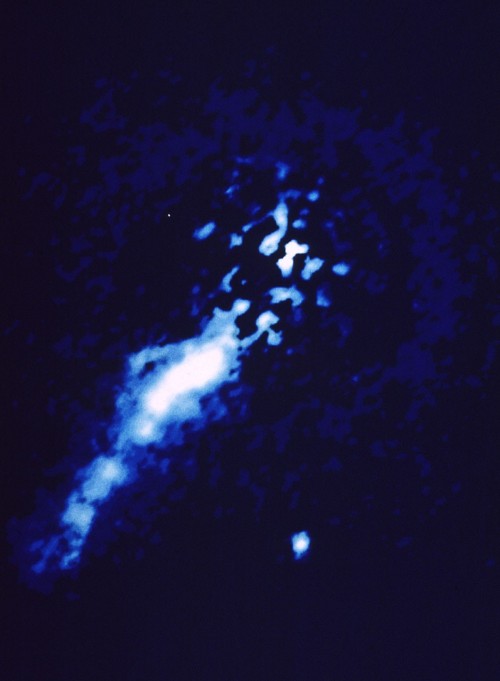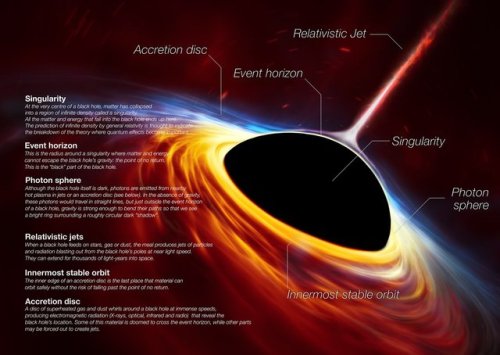#supermassive black hole
OLD ART: THE GALACTIC CITY (PART 1)
I’ve still been working on the novel I am trying to write with my celestial body characters in my spare time (gone through so many drafts already) but I’m not sure if it will ever see the light of day.
The celestial body characters originally started out as comics sketched out by me in middle school, and after I realized I would never be able to color the longer-form comics AND the one-off gag comics on a regular basis, I decided to try to write the longer stories instead.
The problem is that it feels like people expect books to be much more realistic than comics, and it has been a nightmare trying to get a story that ultimately is about love between a sunlike star and a supermassive black hole into a realistic framework. It is a fundamentally unrealistic story, yet one that requires so much science knowledge it has as much science in it as a hard science fiction novel, without the benefits of being, you know, plausible.
I recently dragged the old comics from high school out of a drawer, and admired, in spite of their crudeness and complete lack of realistic worldbuilding, the sheer irreverence of them.
Want a galaxy that’s a literal city? Sure.
Want Wolf-Rayet star biker gangs? Sure.
A supermassive black hole that can just go to the grocery store? Sure.
…I’m going to be posting the comic called “The Galactic City,” as it is the first time I conceived of the setting of a distant quasar that’s a rough and violent city of stars and black holes. It’s no longer a literal city (more of a metaphorical one) nowadays, but I do have a certain nostalgia for when I just didn’t care.
Post link
Looking to the New Year we find the world has changed dramatically.
But perhaps once we get over this darkness, a whole new world awaits…
This is meant to depict Stella sitting on Tartarus’ accretion disk, looking out over the dark ring of thick dust clouds (called the ”torus” in astronomy) that surrounds it, and into the nuclear star cluster. The nuclear star cluster of their galaxy is like the stars’ capital city. It has taken a beating from the winds of the active galactic nucleus Tartarus powers, but yet it persists, deeply changed, but resilient.
The strange threads sticking out of the accretion disk are plasma filaments that have been lifted up by magnetic fields. In my writing I usually describe the torus as being almost like a circular mountain range from the stars’ perspective (they call it the Torus Mountains), and the accretion disk as a turbulent blue sea. So I drew the torus and accretion disk to resemble a mountain range looming over the ocean. I thought it was interesting though to make the filaments look almost like enormous strands of prairie grass, waving in the AGN wind.
Strictly speaking this isn’t the most realistic depiction of an accretion disk and torus (for one thing the brightness of the disk should look uniform on Stella’s scale, but then that would mask the other features present in it) but I find it poetic. Sometimes space dust clouds do really resemble Earthly land forms, and in a setting where stars are civilized it makes sense they would think of the clouds’ dark, rugged silhouette as their equivalent of the shadow of a mountain range set against the night sky.
Post link
DUELING SUPERMASSIVE BLACK HOLES
I like to imagine that supermassive black holes are incredibly territorial. They may tolerate millions of smaller black holes orbiting among them and feeding from their AGN disks, but put two supermassive black holes in the same galaxy, and they get consumed by a murderous rage that THERE CAN ONLY BE ONE.
They charge towards each other, throwing entire star systems aside like they’re little more than pebbles as they prepare to enact the deadly ritual all supermassive black holes do to decide who gets to share the merged galaxy. The gas gathers around them in a frightful disk, narrow streams feeding from its inner edge onto frightfully hot whirlpools surrounding each individual hole. The lower-mass one takes a position close to the disk’s inner edge, hoping it can gobble up enough mass to rival the bigger one and win the challenge.
Chanting murderous mantras and horrific oaths in gravitational waves the two black holes spiral together, their event horizons joining, and in the final throwdown their consciousnesses duke it out to determine which will control the merged black hole space-time.
If the mass ratio is imbalanced, then the bigger one just got an absolutely glorious meal. But if it isn’t…fate hangs in the balance…
Post link
HAPPY THANKSGIVING FROM INSIDE THE EVENT HORIZON
Have a very bloated Tartarus after he’s feasted on gas kicked up by a galaxy merger and then eaten the other galaxy’s supermassive black hole.
Of course after a few hours his space-time will have settled down completely and he’ll be extremely hungry again, but for now he’s enjoying
digesting the other SMBHthe ring-down.
Post link
BLACK HOLE IN THE COFFEE MUG!!!
…Seriously.
SO…MUCH…SWIRLY!
(Inspired by the Event Horizon Telescope project, which is a bunch of astronomers trying to network a bunch of radio telescopes together to image the supermassive black holes at the center of the Milky Way and M87)
TheEvent Horizon Telescope is supposed to release their results for the first time this year, so might as well reblog this old image. I drew this way back in undergrad.
Well…they finally did it. Congrats to everyone who worked on the Event Horizon Telescope!
Well, they did it again last week…now we just have to wait a million years for us to finally get a large enough interferometer to resolve any other black hole other than M87* and SgrA*…
Post link
The star thrashed about as he was caught in the rush of inspiraling gas. Choking plasma forced its way onto his surface, colliding in superheated shockwaves. For the first time, the star felt a burning sensation. It was a peculiar thing, to say the least, given he was himself a great source of heat. But the dense plasma smashing across his face heated up to temperatures orders of magnitude higher than his own, scorch-flashing the side of him that faced into the current. Swirling currents and winds whirled about within him, trying and failing to redistribute the heat that was basting him alive.
…Through it all, the supermassive black hole patiently observed, feeling the star’s gravitational well alight on the outer reaches of his space-time, where the curvature was almost flat. Slowly the star was spiraling inward. Slowly. It would take it more than ten thousand orbits before it came within striking range.
But that was enough to pique the black hole’s excitement, and let a little bit of electron-positron plasma drool out of its otherwise shadowy maw…
(Inspired by this paper here: https://arxiv.org/abs/2110.03741)
Post link
OLD ART- THE GALACTIC CITY - PART 10
More of the comic I sketched in middle school that first introduced the character of Tartarus and the setting of a distant quasar that is like a city-state.
You might be a little confused as to why the wormhole tells the Great Annihilator he will take him to NGC 417, when I previously described this galaxy as being called “Antiocheka”…that is because when I originally conceived of the setting, I just picked a random NGC number for it and thought that was good enough. Of course, then I found NGC 417 is a nondescript lenticular galaxy, so I needed to change it to being a quasar. I then for a while called this galaxy HS 1946+7658, which was the most luminous quasar known at the time. Eventually I gave up on trying to make the setting a real place (because there aren’t really any galaxies that are cities of sapient stars) and just gave it the name Antiocheka.
In these specific pages, the Great Annihilator finishes telling Tartarus his story of misery and woe, and cries…like usual. This time Tartarus cries with him, though. Even as a 14-year old I knew that Tartarus’ backstory was going to be of a small and starving stellar black hole that worked its way up to supermassive status. This is hinted at here.
Currently, most astronomers believe that supermassive black holes were born already very large, as they appear shortly after the Big Bang, and other normal models of black hole accretion, that isn’t enough time for a small black hole to grow big. I imagine this to be true of the other supermassive black holes in Tartarus’ cosmic vicinity.
But Tartarus’ unique status as having originally been a stellar black hole means he is able to empathize with much smaller black holes when other supermassive black holes generally do not. Tartarus is somewhat unusual for being a leader and caretaker of the millions of black holes that orbit him…most other supermassive black holes just kind of indifferently absorb smaller black holes if they feel like.
One thing that has changed in my conception of Tartarus since middle school is his opinion on consuming stars. I always knew he was reluctant to consume stellar black holes, but I depicted him as very much seeking out stars to devour. Now I imagine he mostly would prefer to eat giant molecular clouds, as they are more massive and easier to accrete, and don’t scream inside him when he swallows them*. He still might half-jokingly tell other stars he wants to eat them, though, and get tempted if he is particularly hungry…
*Black holes larger than 10 billion solar masses swallow all the stars they eat whole, even giant stars. Tartarus is at least that massive (his exact mass is something I never seem to decide on) so when he eats stars they totally are alive inside him for some time and screaming and thrashing. Needless to say that feels…kind of disturbing to him.
Post link
PIZZACCRETION DISK
There is something about black holes eating conspicuously human food that I find funny for some reason. When I look at the drawings I did in middle school and high school, there are so many of them where I drew my black hole characters eating at restaurants and buffets and such. I usually “justified” this by saying the fish fillets were just comets with fishlike tails, or that the pasta was really strands of hydrogen plasma, but it was more of an excuse than anything else.
It doesn’t really make sense for Tartarus to eat human food at all given 1) his galaxy is billions of light years away from the Milky Way 2) the stories and comics with him are set billions of years before humans existed and 3) human food simply cannot be made in quantities interesting enough to a supermassive black hole…but what if it did???
I got a bit tired of Tartarus always appearing as a big black wall in front of Stella, so in this comic I have Stellar far in front of him so he fits completely on the page. Of course I then have a starship that is presumably is also way in front of Stella (since it is similar in projected size to her), but then I drew Stella looking to the side so…
Post link
Some diagrams I hand-drew to use in the AGN planetarium show. My digital art software has been non-functional lately so I figured I might as well go back to colored pencil. The first page is just a diagram of all the structures associated with accreting supermassive black holes (AGN stands for active galactic nucleus which is how the actively feeding black hole manifests from the outside…as a bunch of weird activity in the center of a galaxy). The latter diagram shows the name of different astrophysical phenomena that are all thought to be due to accreting supermassive black holes.
For those that don’t know…
The supermassive black hole feeds from a whirlpool of plasma called an accretion disk. The accretion disk emits a lot of high-intensity ultraviolet light, which ionizes the galaxy in a broad swath called the ionization cone. The two main regions of ionized gas that are observed by astronomers are the broad line region (BLR) and narrow line region (NLR). The BLR is gas that is located close to the accretion disk in the center of the galaxy, and is thought to be moving rapidly, but observations are mixed as to whether the motion is an outflow (shown here), inflow, or simply rotation. The NLR is much more rarefied gas that occupies the ionization cone, and such extends through length scales comparable to the galaxy itself. All of these portions of the AGN features emit in optical light.
Sometimes astronomers can see the BLR and accretion disk light, but most of the time they cannot. To explain this, the AGN unification hypothesis posits that a thick ‘donut’ of cooler gas and dust–the torus–surrounds the BLR. When our line of sight is intercepted by the torus it blocks the BLR from view (”obscuration”). The torus radiates in the mid-infrared.
Just above and below the accretion disk is the corona, which is where UV photons from the accretion disk are boosted up to X-ray energies (hence why I have depicted them as the stereotypical radioactive green). The corona lies at the base of relativstic jets, powerful beams of fast-moving particles that extend out from the center of the galaxy and sometimes go on to punch into intergalactic space. When they do, they can carve enormous cavities into the gas that surrounds galaxies as they gradually slow down and pool into clouds of radio-emitting plasma called radio lobes. The jets are prominent in radio, but emit across the whole electromagnetic spectrum.
The weird thing about jets is that while AGN are famous for them most AGN do not have visible jets. This is why I have chosen to call the powerful AGN QSOs (”quasi-stellar objects”) rather than the more famous quasar. The word quasar comes from “quasi-stellar radio source” and was coined because the first discovered quasar had a prominent radio jet, but most quasars discovered since don’t emit in radio prominently.
The reason for this is unknown. It could be an orientation effect (similar to how we cannot see the BLR in most AGN), but it might also be an intrinsic difference since theoretical models show jets form only at certain accretion levels.
The other big AGN unification mystery is what the source of the obscuration of the BLR really is. Based on the vanilla torus explanation, one would not expect say, AGN in merging galaxies to be more heavily obscured than AGN in isolated galaxies, but this nonetheless is the case. Astronomers currently think obscuration can also be due to random dust clouds in the galaxy, not just the torus. And we don’t exactly know what the torus is either. Does it condense out of the material flowing into the supermassive black hole? Or out of it? Or is it some sort of ‘food reservoir” that the black hole can accrete from?
Post link
Just some single-panel cartoons I am hoping to include in a planetarium show I hope to give next year.
They’re meant for a part of the talk that describes how black holes isolated by themselves don’t really do much, but once they’re actively accreting matter, they become a lot more exciting.
So if you’re a little star, don’t go around poking black holes because they seem dead. You wouldn’t like them when they ‘come alive’…
Post link
OLD ART: THE GALACTIC CITY - PART 5
More from the old comic I sketched in middle school, “The Galactic City.”
Previously The Great Annhilator blew up his own apartment with his own spit, and here he explains it’s because he can generate antimatter.
Of course since I didn’t really understand physics in those days, I attributed this to him having magical “antimatter glands.”
In reality The Great Annihilator’s antimatter spit isn’t really unique to it, it’s a process that all black holes can use. Positron-electron pairs will naturally foam into existence in environments with a large flux of gamma rays and strong magnetic fields, such as the base of black hole jets.
We then see The Great Annihilator’s backstory back when he lived in the Milky Way and was friends with the supermassive black hole there (here?), Sagitarrius A*. Of course given that this setting depicts galaxies as literal cities, the Milky Way is also depicted as a place full of buildings and streets.
When the Milky Way Matter Famine starts, the stars do not allow the black holes to eat anything. This is attributed in this comic to a nebulous bigotry the stars have. However as I got older, I realized that it didn’t really make sense to depict the stars as being in the wrong here when I depicted the black hole characters as intentionally seeking out and devouring baby stars.
In my current, more realistic interpretation of the whole “galaxy is a civilization of stars” setting, the divide between stars and black holes is essentially due to a misunderstanding of physics.
You see, in general relativity there is something called the “no hair theorem.” Basically it states that two black holes can only be distinguished by three properties: mass, spin, and electric charge. This implies they are very simple objects, far simpler than even rocks. It gets even worse for black holes out there in space, because they’re unlikely to possess an electric charge–that leaves them with just two (!) distinguishing parameters.
In essence the stars are convinced the black holes are not sentient because of the no hair theorem.
But as it turns out the no hair theorem only applies to isolated black holes in equilibrium. Black holes that are actively accreting can possess different features, such as space-time asymmetries, magnetic fields, and lots of complex interactions with the matter flowing into them. In real life this doesn’t mean they’re alive, but in a setting like this one where all the celestial bodies are alive in some way, it means they can be conscious while accreting.
The reason the stars never realized that is two-fold: the black holes speak a gravitational wave language the stars cannot detect well enough to view as anything other than animalistic noises, and the stars actively keep the black holes starving. In my current conception of this setting, the black holes are perfectly content to consume nonliving matter, but the stars claim all the galaxy’s dust and gas for their own use, both to build more stars and to be used as raw materials for technologies. The black holes devour stars not because they particularly want to, but because they are starving and being deprived of what they need to remain conscious beings.
Post link
OLD ART-THE GALACTIC CITY-PART 4
More of that embarrassing comic from 8th grade (not high school it’s even older than that)…it’s really kind of ridiculous how the black holes live in wooden buildings and have so much organic anatomy.
I wasted a lot of the viewer’s time in those days going into random details of how the black holes had apparently ruminant digestive tracts, and a lot of weird stomach rumbles and other gross bodily functions. However there is a reason for that.
It is perhaps here I should confess that as far back as I can remember, I have had an intense phobia of being swallowed whole and digested alive (I’m not sure why but I blame watching Pinocchioas a toddler.) As a result I hate encountering anything that reminds me of that, like growling stomachs, close ups of throats/uvulas, and belches/farts. I would always end up being pissed off when a TV show I was watching or a book I was reading would have a character’s stomach growl, or worse, had a surprise scene that took place inside a monster’s stomach (needless to say, I hate Finding Nemo.)
However, when Iwas the author/artist, I liked being able to take control of the things I feared. I could decide if a character’s stomach would growl here or not. Iwould decide if there’s a swallowed-whole scene. There was something powerful about that for me, that I could depict the things I hated seeing in others’ work and make it my own. I think it was a kind of exposure therapy, in a way (the tons of comics/writing I do about natural disasters is for similar reasons…I get freaked out even by ordinary thunderstorms…)
Of course I overdid it a lot, which you can see here in the form of me giving the black holes gross organic anatomy. I still do imagine in my current conception of this setting that the black holes have some processes of their space-time that function like a digestive tract, but it’s not a literal gross fleshy thing anymore. The whole “black holes have intense hunger pangs” thing is still true in this world though…I imagine they would be gravitational waves that shake space-time.
To be honest, I think this phobia is why I got so interested in black holes in the first place…because it lets me tangentially approach the concept of being swallowed whole and alive without anything literally being eaten. In real life, I don’t have a lot of interest in predatory animals like some people, because I feel so terrible for the prey. But when a supermassive black hole swallows a star, nothing is *really* being digested and dying, so it feels a lot less scary.
Post link
OLD ART - THE GALACTIC CITY, PART 3
More of that old comic I sketched when I was 16 because pandemic got me in a creative slump.
I didn’t really have a lot of consistency in the physics in those days and so the black holes were vulnerable to things like poison, electrocution, etc. They also lived in underground caves and entered buildings, because in my conception at the time, the setting was like those cartoons with talking animals that live in cities and act like humans.
Of course, once I entered college, I realized that while there are no laws of physics stopping you from putting clothes on an aardvark and making him work an office job in a cubicle, there is a lot of physics stopping you from making a star walk around on a street and live in a townhouse. So the setting for these characters now is Very Definitely In Space ™.
They still are pretty anthropomorphic though in their thoughts and actions and desires so it’s not a masterpiece of realistic world-building.
The problem is that when you make a “realistic” black hole character you get some incomprehensible alien eldritch abomination, and at that point they can’t be a main character you sympathize with anymore (*cough* *cough* Gregory Benford *cough* Eater*cough).
I’ve always been enamored with the idea of a world in which powerful forces of nature orders of magnitude more vast then us still struggle with very humanlike faults and foibles (I wrote a whole short story told from the perspective of a sympathetic Hurricane Harvey for Pete’s sake), even if that is not the most “realistic” perspective to take.
Post link
OLD ART: THE GALACTIC CITY, PART 2
More of the comic where in high school I first conceived of the setting of my celestial body characters. As you can see they originally were very humanlike, had fleshy organic body parts, etc.
You can see Tartarus’ original design here. Originally he was nicknamed “Hawking” and preferred to be called this instead of Tartarus; I later got rid of it because naming a black hole after Stephen Hawking sounded the exact opposite of intimidating.
He had an Alien-style second set of pharyngeal jaws that were meant to represent his inner event horizon; this is a surface inside a rotating black hole where streams of matter and energy collide and build up to crushing energies. In reality they’re thought to form singularities, not jaws, but 16 year old me thought depicting them as jaws would be cool.
He also wore spiked bracelets and sunglasses…which doesn’t make a lot of sense for a supermassive black hole, but still isn’t as bad as the Great Annihilator’s longcoat and broad-brimmed hat.
The Great Annihilator is a stellar black hole in the center of the Milky Way that has very powerful positron-electron jets. The positrons and electrons annihilate with one other, creating gamma rays, hence the name. In my original conception of the Antiocheka quasar, The Great Annihilator was a refugee from the “Milky Way Matter Famine” who fled to the quasar galaxy. He speaks in a “Virgo Cluster Accent” that basically is my bad attempt at spelling out a Southern dialect.
As the setting became more realistic, the Great Annihilator was gone. There’s no real reason someone from the Milky Way would go to a quasar…the nearest one is more than a billion light years away.
I do still have a certain nostalgia for the idea of a black hole as famine refugee and the idea of a black hole with a hat. Maybe someday I’ll make one with a hat-shaped corona? We technically don’t know the shape of black hole coronae so maybe a hat isn’t as far fetched as you would think…
…There is a perception that when astrophysicists make fictional settings and stories, it has to be iron-hard. It certainly seems to be the trend I notice. But then there’s me, who is like “dammit I want a black hole with a hat, and I’m gonna get a black hole with a hat.”
Post link
Illustration by Jack Ciurlo of G objects in Sagittarius A. Click the source link to learn about these strange celestial bodies.
Post link

